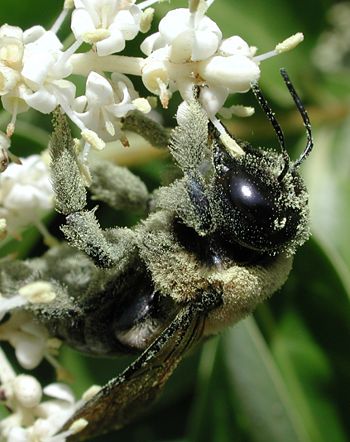Carpenter bee
Carpenter bees (the genus Xylocopa in the subfamily Xylocopinae) are large, hairy bees distributed worldwide. There are some 500 species of carpenter bee in 31 subgenera[1]. They can be important pollinators on open-faced flowers, though many species are also known to "rob" nectar by slitting the sides of flowers with deep corollas. All species but those in the subgenus Proxylocopa, which nest in the ground, build their nests in burrows in dead wood, bamboo, or structural timbers. In several species, females will live in tunnels alongside their own daughters or sisters, creating a sort of social group. They use wood bits to form partitions between the cells in the nest. A few species bore holes in wood dwellings and earn the enmity of some homeowners, though others regard them as pets. Male bees are seen hovering around the nest, and will approach nearby animals. However, the male is harmless since it does not have a stinger.[2] Female bees do have a stinger, but are preoccupied with foraging and will only return to the nest to stockpile. Female bees are not aggressive, and will not sting unless directly provoked. Since the tunnels are near the surface, structural damage is generally minor or nonexistent. A building at Cornell University possibly containing nests since the early-1930s, with very heavy nesting between 1966 and 1995, is still sound in 2006.
In the United States of America, there are two eastern species, Xylocopa virginica, and Xylocopa micans, and three other species that are primarily western in distribution. X. virginica is by far the more widely distributed species([3]). Some are often mistaken for a bumblebee species, as they can be similar in size and coloration, though most carpenter bees have a shiny abdomen, while in bumblebees the abdomen is completely clothed with dense hair. Males of some species have a white or yellow face, where the females do not; males also often have much larger eyes than the females, which relates to their mating behavior.
Many Old World carpenter bees have a special pouch-like structure on the inside of their first metasomal tergite called the acarinarium where certain species of mites (Dinogamasus spp.) reside as commensals. The exact nature of the relationship is not fully understood, though in other bees that carry mites, the mites are beneficial, feeding either on fungi in the nest, or on other, harmful mites.
Members of the related tribe Ceratinini are sometimes referred to as "Small Carpenter Bees".
Behavior
Carpenter bees are traditionally considered solitary bees, though some species have simple social nests in which mothers and daughters may cohabit. However, even solitary species tend to be gregarious, and often several will nest near each other.
Carpenter bees make nests by tunneling into wood, vibrating their bodies as they rasp their mandibles against the wood, each nest having a single entrance which may have many adjacent tunnels. Carpenter bees do not eat wood. They discard the bits of wood, or re-use particles to build partitions between cells. The tunnel functions as a nursery for brood and the pollen/nectar upon which the brood subsists. The provision masses of some species are among the most complex in shape of any group of bees; whereas most bees fill their brood cells with a soupy mass, and others form simple spheroidal pollen masses, Xylocopa form elongate and carefully sculpted masses that have several projections which keep the bulk of the mass from coming into contact with the cell walls, sometimes resembling an irregular caltrop. The eggs are very large relative to the size of the female, and are some of the largest eggs among all insects.
There are two very different mating systems that appear to be common in carpenter bees, and often this can be determined simply by examining specimens of the males of any given species. Species in which the males have large eyes are characterized by a mating system where the males either search for females by patrolling, or by hovering and waiting for passing females, whom they then pursue. In the other type of mating system, the males often have very small heads, but there is a large, hypertrophied glandular reservoir in the mesosoma, which releases pheromones into the airstream behind the male while it flies or hovers. The pheromone advertises the presence of the male to females[4].
Generally carpenter bees are excellent pollinators of open-faced flowers, but their habit of slitting the corolla and robbing nectar without pollination makes them undesirable for flowers with a deep corolla, such as blueberries.
Attribution
- Some content on this page may previously have appeared on Wikipedia.
References
- ↑ Minckley, R.L. 1998. A cladistic analysis and classification of the subgenera and genera of the large carpenter bees, tribe Xylocopini (Hymenoptera: Apidae). Scientific Papers, Natural History Museum, University of Kansas 9:1-47
- ↑ University of Kentucky Entomology: Carpenter Bees
- ↑ Carpenter bee images by Mark A. Chappell
- ↑ Minckley, R.L., Buchmann, S.L., Wcislo, W.T. 1991. Bioassay evidence for a sex attractant pheromone in the large carpenter bee, Xylocopa varipuncta (Anthophoridae: Hymenoptera). J. Zool. Soc. London 224: 285-291
